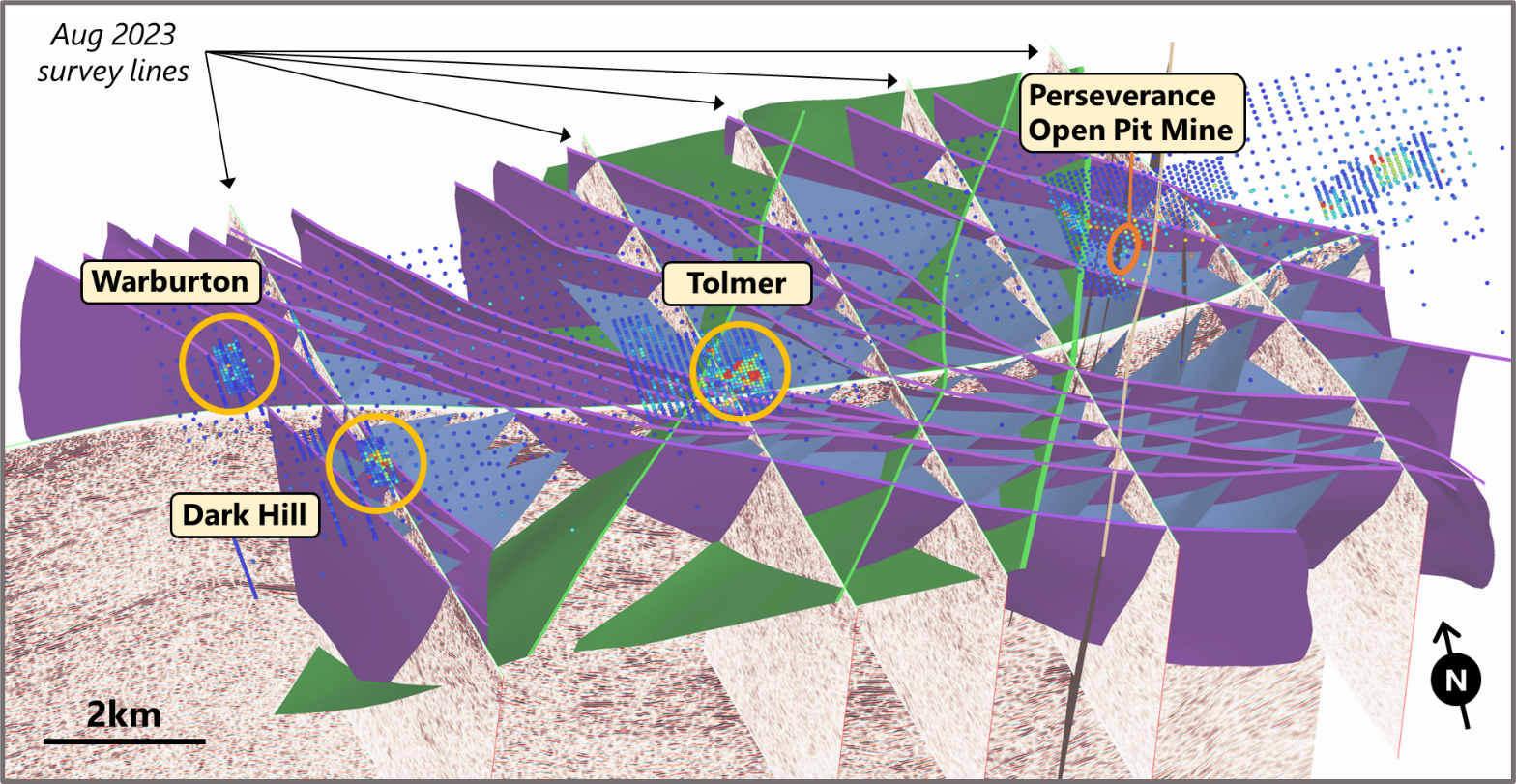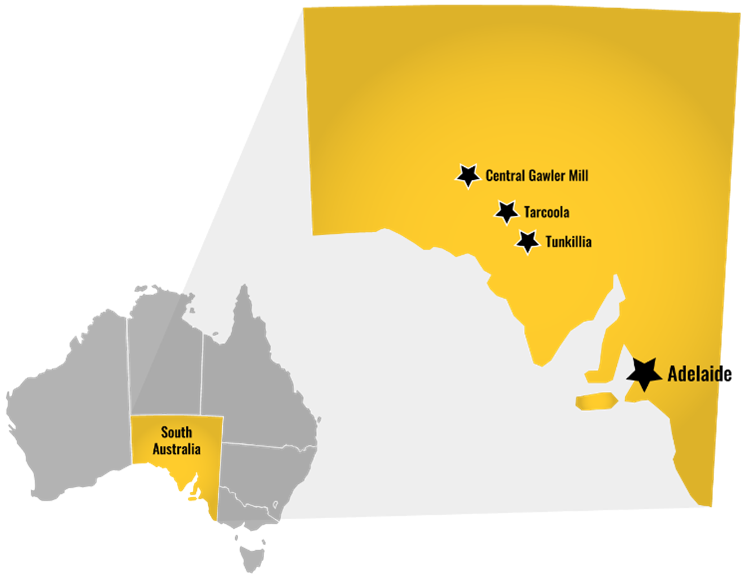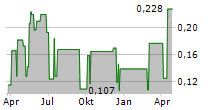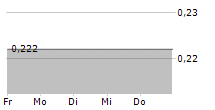
ADELAIDE, AUSTRALIA / ACCESSWIRE / June 14, 2024 /
HIGHLIGHTS
- Known Tarcoola gold mineralisation tied into consistent structural framework
- Multiple new previously untested structures mapped across key target zone
- Aerial footage of August 2023 seismic program in action can be viewed here
Barton Gold Holdings Limited (ASX:BGD)(FRA:BGD3)(OTCQB:BGDFF) (Barton or the Company) is pleased to announce seismic analysis results from the Tarcoola Gold Project (Tarcoola), where in August 2023 HiSeis completed a detailed survey using a combination of accelerated weight drop and Vibroseis trucks.1
The survey successfully mapped several new and previously untested structures across the historical Tarcoola Goldfield, with preliminary analysis indicating that gold mineralisation is closely associated with deeper-tapping sub-vertical structures similar to the Perseverance Fault.

Commenting on the Tarcoola seismic survey results, Barton MD Alex Scanlon said:
"We are excited to see the Tarcoola Goldfield's detailed architecture for the first time since its discovery 130 years ago. With little modern exploration and a history of high-grade production from over 600 shallow historical workings, the potential for exciting new discoveries is significant. We are analysing these results in combination with our other data sets, and expect to drill test our highest-priority exploration targets during early 2024."
Background & Program Overview
During 2020 Barton completed a high-definition reprocessing of historical seismic data around Tarcoola to better understand the local structural architecture.1 The results confirmed the location and orientation of the Perseverance Fault (which controls the mineralisation of the Perseverance Mine) and identified a system of major structures analogous to the Perseverance Fault across the historical Tarcoola Goldfield.2
In August 2023 the Company completed a new seismic survey over this target area, collecting over 40 line-km of data along 5 lines to develop a higher resolution model of near surface (0-500m depth) structures.3


Key Observations from New August 2023 Seismic Survey
The Perseverance Mine is located on Mining Lease (ML) 6455 and was operated during 2017 and 2018, with an average ore grade of ~3.8 g/t Au sent to the Company's Central Gawler Mill during 2018.4 The latest analysis indicates a corridor of Perseverance Fault-like structures located just west of the open pit.

The new model (fig. 5) suggests that gold tends to occur in association with early NE trending structures (blue), in the footwall of NNE trending sinistral basin faults (green), and in the footwall of later NW trending faults (purple). This is the first time that known gold occurrences can be put into a structural framework. Larger occurrences appear to be closely associated with deep-tapping sub-vertical structures like the Perseverance Fault, with several such structures newly identified through this seismic analysis.

Authorised by the Board of Directors of Barton Gold Holdings Limited.
For further information, please contact:
| Alexander Scanlon Managing Director a.scanlon@bartongold.com.au +61 425 226 649 | Shannon Coates Company Secretary cosec@bartongold.com.au +61 8 9322 1587 |
1 Refer to ASX announcements dated 7 / 14 August 2023
2 Refer to Prospectus dated 14 May 2021
3 Refer to ASX announcements dated 7 / 14 August 2023
4 Refer to Prospectus dated 14 May 2021
Competent Persons Statement
The information in this announcement that relates to new Exploration Results for the Tarcoola Gold Project (including drilling, sampling, geophysical surveys and geological interpretation) is based upon, and fairly represents, information and supporting documentation compiled by Mr Marc Twining BSc (Hons). Mr Twining is an employee of Barton Gold Holdings Ltd and is a Member of the Australasian Institute of Mining and Metallurgy Geoscientists (AusIMM Member 112811) and has sufficient experience with the style of mineralisation, the deposit type under consideration and to the activity being undertaken, to qualify as a Competent Person as defined in the 2012 Edition of the "Australasian Code for Reporting of Exploration Results, Mineral Resources and Ore Reserves" (The JORC Code). Mr Twining consents to the inclusion in this announcement of the matters based upon this information in the form and context in which it appears.
About Barton Gold
Barton Gold is an ASX, OTCQB and Frankfurt stock exchange listed Australian gold exploration company with a total attributable 1.3Moz Au JORC Mineral Resources endowment (40.6Mt @ 1.0 g/t Au), a pipeline of advanced exploration projects and brownfield mines, and 100% ownership of the only regional gold mill in the central Gawler Craton of South Australia.*

Tarcoola Gold Project
- Existing brownfield open pit mine within trucking distance of Barton's processing plant
- Under-explored asset with untapped scale potential
Tunkillia Gold Project
- 1.15Moz Au Mineral Resources (38Mt @ 0.94 g/t Au)*
- District-scale structures with advanced satellite targets
Infrastructure
- 650ktpa CIP process plant, mine village, and airstrip
- Tarcoola ~40 person lodging to support mine operations
- Tunkillia camp to support dedicated project team
Competent Persons Statement & Previously Reported Information
The information in this announcement that relates to the historic Exploration Results and Mineral Resources as listed in the table below is based on, and fairly represents, information and supporting documentation prepared by the Competent Person whose name appears in the same row, who is an employee of or independent consultant to the Company and is a Member or Fellow of the Australasian Institute of Mining and Metallurgy (AusIMM), Australian Institute of Geoscientists (AIG) or a Recognised Professional Organisation (RPO). Each person named in the table below has sufficient experience which is relevant to the style of mineralisation and types of deposits under consideration and to the activity which he has undertaken to quality as a Competent Person as defined in the JORC Code 2012.
Activity | Competent Person | Membership | Status |
| Tarcoola Mineral Resource | Dr Andrew Fowler (Consultant) | AusIMM | Member |
| Tarcoola Exploration Results (until 15 Nov 2021) | Mr Colin Skidmore (Consultant) | AIG | Member |
| Tarcoola Exploration Results (after 15 Nov 2021) | Mr Marc Twining (Employee) | AusIMM | Member |
| Tunkillia Exploration Results (until 15 Nov 2021) | Mr Colin Skidmore (Consultant) | AIG | Member |
| Tunkillia Exploration Results (after 15 Nov 2021) | Mr Marc Twining (Employee) | AusIMM | Member |
| Tunkillia Mineral Resource | Dr Andrew Fowler (Consultant) | AusIMM | Member |
| Challenger Mineral Resource | Mr Dale Sims (Consultant) | AusIMM / AIG | Fellow / Member |
| Western Gawler Craton JV Mineral Resource | Mr Richard Maddocks (Consultant) | AusIMM | Fellow |
The information relating to historic Exploration Results and Mineral Resources in this announcement is extracted from the Company's Prospectus dated 14 May 2021 or as otherwise noted in this announcement, available from the Company's website at www.bartongold.com.au or on the ASX website www.asx.com.au. The Company confirms that it is not aware of any new information or data that materially affects the Exploration Results and Mineral Resource information included in previous announcements and, in the case of estimates of Mineral Resources, that all material assumptions and technical parameters underpinning the estimates in the Prospectus continue to apply and have not materially changed. The Company confirms that the form and context in which the applicable Competent Persons' findings are presented have not been materially modified from the previous announcements.
Cautionary Statement Regarding Forward-Looking Information
This document may contain forward-looking statements. Forward-looking statements are often, but not always, identified by the use of words such as "seek", "anticipate", "believe", "plan", "expect", "target" and "intend" and statements than an event or result "may", "will", "should", "would", "could", or "might" occur or be achieved and other similar expressions. Forward-looking information is subject to business, legal and economic risks and uncertainties and other factors that could cause actual results to differ materially from those contained in forward-looking statements. Such factors include, among other things, risks relating to property interests, the global economic climate, commodity prices, sovereign and legal risks, and environmental risks. Forward-looking statements are based upon estimates and opinions at the date the statements are made. Barton undertakes no obligation to update these forward-looking statements for events or circumstances that occur subsequent to such dates or to update or keep current any of the information contained herein. Any estimates or projections as to events that may occur in the future (including projections of revenue, expense, net income and performance) are based upon the best judgment of Barton from information available as of the date of this document. There is no guarantee that any of these estimates or projections will be achieved. Actual results will vary from the projections and such variations may be material. Nothing contained herein is, or shall be relied upon as, a promise or representation as to the past or future. Any reliance placed by the reader on this document, or on any forward-looking statement contained in or referred to in this document will be solely at the readers own risk, and readers are cautioned not to place undue reliance on forward-looking statements due to the inherent uncertainty thereof.
* Refer to Barton Prospectus dated 14 May 2021 and ASX announcement dated 26 April 2023. Total Barton attributable JORC (2012) Mineral Resources include 679koz Au (22.2Mt @ 1.0 g/t) in Indicated and 618koz Au (18.36Mt @ 1.0 g/t) in Inferred categories. Pursuant to Barton's ASX announcement of 1 September 2023 it is anticipated that total JORC Mineral Resources will reduce by ~61.4koz Au.
JORC Table 1 - Tarcoola Gold Project & 2D Seismic Survey
Section 1 Sampling Techniques and Data
Criteria | Commentary |
Sampling techniques Nature and quality of sampling (e.g. cut channels, random chips, or specific specialised industry standard measurement tools appropriate to the minerals under investigation, such as down hole gamma sondes, or handheld XRF instruments, etc.). These examples should not be taken as limiting the broad meaning of sampling. Include reference to measures taken to ensure sample representivity and the appropriate calibration of any measurement tools or systems used. Aspects of the determination of mineralisation that are Material to the Public Report. In cases where 'industry standard' work has been done this would be relatively simple (e.g. "RC drilling was used to obtain 1 m samples from which 3 kg was pulverised to produce a 30 g charge for fire assay"). In other cases, more explanation may be required, such as where there is coarse gold that has inherent sampling problems. Unusual commodities or mineralisation types (e.g. submarine nodules) may warrant disclosure of detailed information | Not applicable. No new drilling results reported. |
Drilling techniques Drill type (e.g. core, RC, open-hole hammer, rotary air blast, auger, Bangka, sonic, etc.) and details (e.g. core diameter, triple or standard tube, depth of diamond tails, face-sampling bit or other type, whether core is oriented and if so, by what method, etc.). | Not applicable. No new drilling results reported. |
Drill sample recovery Method of recording and assessing core and chip sample recoveries and results assessed. Measures taken to maximise sample recovery and ensure representative nature of the samples. Whether a relationship exists between sample recovery and grade and whether sample bias may have occurred due to preferential loss/gain of fine/coarse material. | Not applicable. No new drilling results reported. |
Logging Whether core and chip samples have been geologically and geotechnically logged to a level of detail to support appropriate Mineral Resource estimation, mining studies and metallurgical studies. Whether logging is qualitative or quantitative in nature. Core (or costean, channel, etc.) photography. The total length and percentage of the relevant intersections logged. | Not applicable. No new drilling results reported. |
Subsampling techniques and sample preparation If core, whether cut or sawn and whether quarter, half or all core taken If non-core, whether riffled, tube sampled, rotary split, etc. and whether sampled wet or dry. For all sample types, the nature, quality and appropriateness of the sample preparation technique. Quality control procedures adopted for all subsampling stages to maximise representivity of samples. Measures taken to ensure that the sampling is representative of the in-situ material collected, including for instance results for field duplicate/second-half sampling. Whether sample sizes are appropriate to the grain size of the material being sampled. | Not applicable. No new drilling results reported. |
Quality of assay data and laboratory tests The nature, quality and appropriateness of the assaying and laboratory procedures used and whether the technique is considered partial or total. For geophysical tools, spectrometers, handheld XRF instruments, etc., the parameters used in determining the analysis including instrument make and model, reading times, calibrations factors applied and their derivation, etc. Nature of quality control procedures adopted (e.g. standards, blanks, duplicates, external laboratory checks) and whether acceptable levels of accuracy (i.e. lack of bias) and precision have been established. | The 2D seismic survey was completed by geophysical contractor HiSeis, based out of Perth, WA. Summary details and specifications relating to the survey are as follows:
|
Verification of sampling and assaying The verification of significant intersections by either independent or alternative company personnel. The use of twinned holes. Documentation of primary data, data entry procedures, data verification, data storage (physical and electronic) protocols. Discuss any adjustment to assay data. | Not applicable. No new drilling results reported. |
Location of data points Accuracy and quality of surveys used to locate drillholes (collar and downhole surveys), trenches, mine workings and other locations used in Mineral Resource estimation. Specification of the grid system used. Quality and adequacy of topographic control. | All co-ordinates for this survey were recorded in the GDA94 (zone 53) UTM grid system. All source and receiver points were located using a differential global positioning system (DGPS), providing ~1cm positional accuracy. |
Data spacing and distribution Data spacing for reporting of Exploration Results. Whether the data spacing and distribution is sufficient to establish the degree of geological and grade continuity appropriate for the Mineral Resource and Ore Reserve estimation procedure(s) and classifications applied. Whether sample compositing has been applied. | A total of 3,958 vibration source point readings were collected at 20m intervals along lines oriented slightly west of North-South. Receiver geophones were positioned at 10m intervals along the same lines utilised for the source points. |
Orientation of data in relation to geological structure Whether the orientation of sampling achieves unbiased sampling of possible structures and the extent to which this is known, considering the deposit type. If the relationship between the drilling orientation and the orientation of key mineralised structures is considered to have introduced a sampling bias, this should be assessed and reported if material. | The precise orientation of all subsurface geological structures was unknown during the planning of the survey. The line orientation was selected on the basis it would be most effective at crossing the principal geological elements (eg stratigraphy) at optimal &/or acceptable angles for subsequent processing. |
Sample security The measures taken to ensure sample security. | Not applicable. No new drilling results reported. |
Audits or reviews The results of any audits or reviews of sampling techniques and data | Not applicable. No new drilling results reported. |
Section 2 Reporting of Exploration Results
Criteria | Commentary |
Mineral tenement and land tenure status Type, reference name/number, location and ownership including agreements or material issues with third parties such as joint ventures, partnerships, overriding royalties, native title interests, historical sites, wilderness or national park and environmental settings. The security of the tenure held at the time of reporting along with any known impediments to obtaining a licence to operate in the area. | The Tarcoola ML Project area lies within Mineral Lease (ML) 6455. ML6455 covers an area of 725.35 ha and is situated completely within Exploration Licence (EL) 6210 which was owned by Tarcoola 2 Pty Ltd a wholly owned subsidiary of Barton Gold Pty Ltd. The Mining Lease is covered by a registered Native Title determination held by the Antakirinja Matu-Yankunytjatjara Aboriginal Corporation (AMYAC). Tarcoola 2 has a deed of agreement with AMYAC and all work programs have been approved by AMYAC. Adjacent to the Perseverance Deposit and the Deliverance/Eclipse Target areas are registered State Heritage Places. The Tarcoola deposit is currently held under a Mining Lease which is listed as Under Care and Maintenance. There are no known impediments to obtaining future licences. |
Exploration done by other parties Acknowledgment and appraisal of exploration by other parties. | The Tarcoola deposit has been subject to sporadic exploration by numerous parties since alluvial gold was first discovered in 1893. Companies who have undertaken drilling include: Newmex Exploration, BHP, Grenfell Resources, AngloGold, Stellar, Hiltaba Gold, Tunkillia Gold and Tarcoola Gold. |
Geology Deposit type, geological setting and style of mineralisation. | The Tarcoola Project covers a portion of the north-western Gawler Craton centred over the historic Tarcoola goldfield, where Archaean and Proterozoic rocks form the basement to an extensive cover of Phanerozoic sediments. The Archaean basement has been extensively deformed, whereas the Proterozoic rocks have been weakly to moderately deformed. At Perseverance (current Tarcoola open pit mine), gold mineralisation is hosted within sedimentary rocks of the Tarcoola Formation and granite, both of Proterozoic age. The granite is variably in fault contact with or unconformably overlain by the sediments, which consists of conglomerate, limestone, sandstone, siltstones, and shale. A suite of later intrusions (Lady Jane Diorite) cut both the sedimentary rocks and the granite. Mafic high level intrusives associated with the 1590Ma Hiltaba Magmatic Event are considered to control the spatial setting of both gold and base metal mineralisation. Three deformation events have been recognised in the area. D1 is characterised by open folding and NNW-directed thrusting, responsibly for the southerly dip of the sedimentary package at Perseverance. Steeply dipping NW and NE trending brittle faults developed during D2. These structures host and control the gold mineralisation in the Tarcoola Ridge area. The third deformation event (D3) is represented by the late E-W trending barren quartz veins. Gold has locally been remobilised and enriched in the weathering profile. The base of complete oxidation occurs typically 10-40m below surface, and the base of partial oxidation occurs at a depth of ~20-60m. Within the primary zone, sericite-quartz-pyrite alteration zones are spatially associated with the mineralisation and overprint earlier hematite-magnetite alteration. An outer halo of chlorite (+/-leucoxene and pyrite) is developed. Pyrite, galena and sphalerite are the main associated sulphide minerals, with subordinate amounts of chalcopyrite bornite and/or arsenopyrite noted. Veins can be discrete or form wider stockwork zones and are surrounded by broader quartz-sericite alteration envelopes which can host lower grade background halos of mineralisation. Dispersed supergene mineralisation in the oxide zone can be largely detached from veining. For more detail see: Budd, A & Skirrow, R, 2007. The Nature and Origin of Gold Deposits of the Tarcoola Goldfield and Implications for the Central Gawler Gold Province, South Australia. Economic Geology, 2007. |
Drillhole information A summary of all information material to the understanding of the exploration results including a tabulation of the following information for all Material drillholes:
If the exclusion of this information is justified on the basis that the information is not Material and this exclusion does not detract from the understanding of the report, the Competent Person should clearly explain why this is the case. | Not applicable. No new drilling results reported. |
Data aggregation methods In reporting Exploration Results, weighting averaging techniques, maximum and/or minimum grade truncations (e.g. cutting of high grades) and cut-off grades are usually Material and should be stated. Where aggregate intercepts incorporate short lengths of high grade results and longer lengths of low grade results, the procedure used for such aggregation should be stated and some typical examples of such aggregations should be shown in detail. The assumptions used for any reporting of metal equivalent values should be clearly stated. | Not applicable. No new drilling results reported. |
Relationship between mineralisation widths and intercept lengths These relationships are particularly important in the reporting of Exploration Results. If the geometry of the mineralisation with respect to the drillhole angle is known, its nature should be reported. If it is not known and only the down hole lengths are reported, there should be a clear statement to this effect (e.g. "downhole length, true width not known"). | Not applicable. No new drilling results reported. |
Diagrams Appropriate maps and sections (with scales) and tabulations of intercepts should be included for any significant discovery being reported These should include, but not be limited to a plan view of drillhole collar locations and appropriate sectional views. | Representative diagrams presenting the location of the seismic lines and representative outputs (both data and interpretations) are included in the body of the release |
Balanced reporting Where comprehensive reporting of all Exploration Results is not practicable, representative reporting of both low and high grades and/or widths should be practiced to avoid misleading reporting of Exploration Results. | Not applicable. No new drilling results reported. |
Other substantive exploration data Other exploration data, if meaningful and material, should be reported including (but not limited to): geological observations; geophysical survey results; geochemical survey results; bulk samples - size and method of treatment; metallurgical test results; bulk density, groundwater, geotechnical and rock characteristics; potential deleterious or contaminating substances. | The information obtained from the recent Seismic survey has been compared against historical magnetic data, gravity data, surface mapping & mining data and drill hole data which has previously been collected to aid the interpretation described in this release. |
Further work The nature and scale of planned further work (e.g. tests for lateral extensions or depth extensions or large-scale step-out drilling). Diagrams clearly highlighting the areas of possible extensions, including the main geological interpretations and future drilling areas, provided this information is not commercially sensitive. | The results from this 2D seismic survey have provided Barton with sufficient context and incentive to pursue further drill testing of targets interpreted to be prospective for identifying additional gold mineralisation. |
SOURCE: Barton Gold Holdings Limited
View the original press release on accesswire.com



